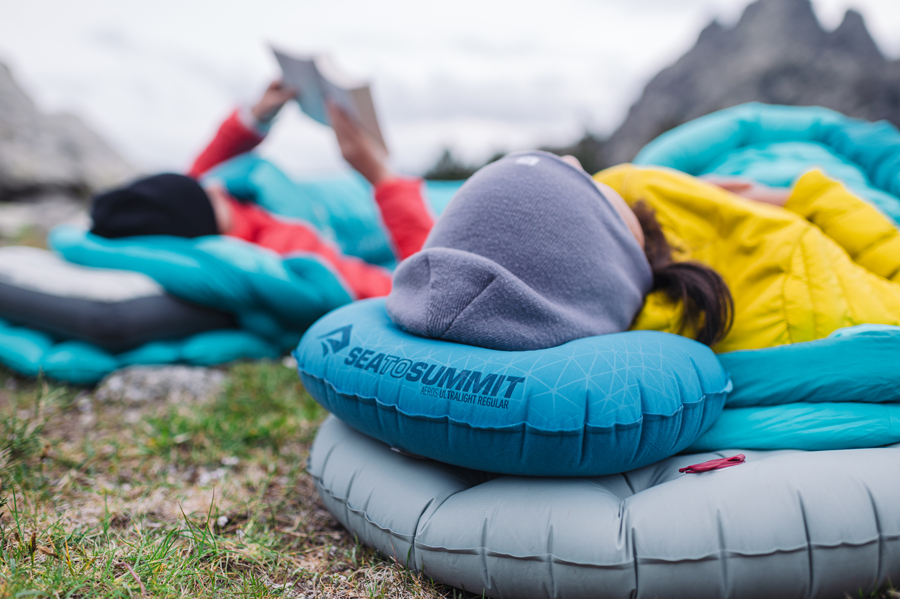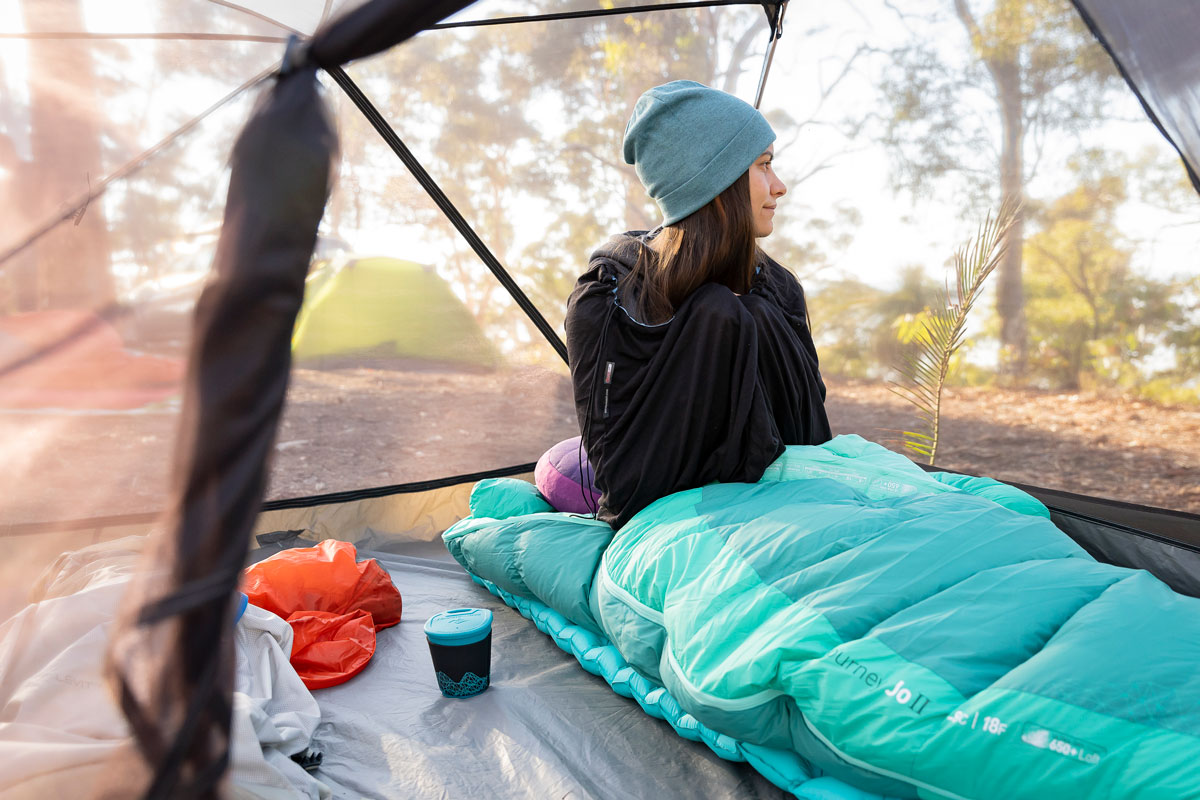Hint: it may not be the sleeping bag
Second only to bear attacks and snake bites, a camper’s biggest fear is sleeping cold. It robs you of your enjoyment—and your focus and energy to ski/run/hike/paddle the next day. In extreme weather, it’s downright dangerous.
So you invest in your sleep. You choose a sleeping bag that seems to tick all the boxes ultralight materials, hydrophobic down, hood, the lot. You brush up on your EN ratings and choose a temperature range that’s suitable for the lower temperatures you’ll be sleeping in.
But your dreams of a refreshing eight hours sleep are crushed. Instead, you spend the night shivering, cursing the name of whoever sold you that hollow down-bag dream. Only your thirst for revenge gets you through the night. Make it to the light of day and you can confront that cheery salesperson who sold you your defunct sleeping bag.
It’s (probably) not the sleeping bag
Sleeping temperatures are a complicated thing. Independent standardised EN 13537 testing, which determines the comfort, lower limit and extreme temperature range of your bag, is just the start. There’s a lot more that factors into it.
So that you never spend another sleepless night cursing your sleeping bag, here are the top ten reasons why you’re sleeping cold—and what to do about it.

1. Your sleeping mat isn’t insulative enough
EN testing—on the face of it—was a gamechanger for sleeping bags, allowing campers to compare how different sleeping bags will perform in different temperatures. Buying a sleeping bag is relatively simple, just choose the temperature range best suited for your conditions. If the lowest temperature you’re sleeping in is 5°C, then a bag with a Comfort rating of 2 °C and a Lower limit of -4°C should have you covered, with a few degrees to spare. Right?
Kind of. It’s important to know that those EN temperature ratings were calculated using a sleeping bag that was paired with a sleeping mat with a high R-value . The sleeping bag in this kind of testing is thus relatively insulated from ground temperatures, which can be a lot colder than the air. The test is also conducted using a mannequin, meaning the rating doesn’t perfectly account for real-world situations—like someone who moves around in their sleep.
Solution
Make sure you choose a sleeping mat that is insulative enough and that you understand the new ASTM F3340-18 R-value testing, introduced in 2019. The right sleeping mat is the foundation of a warm sleep system in cold conditions.
2. Your toes are falling off your mat
Speaking of cold ground temperatures, if your feet or knees are falling off your sleeping mat in the middle of the night, you’re going to fall victim to cold spots. Don’t underestimate how quickly the cold hard ground can sap your body of heat. Letting any part of you touch the cold ground in the night can be like plunging your feet or knees into ice water.
Solution
There are a few ways to make sure you stay off the ground during the night. Choose a sleeping mat that’s long enough for you or surround your mat with your clothes and bags—anything that will keep you on your mat all night.
You can also opt for a wider mat, like our rectangular mats or one of our women’s specific mats, which are wider from the hip to knee to accommodate side sleeping.
Sleep dry, sleep warm
If you’ve been working up a sweat, make sure to change into some warm, dry clothes before bed. Sweat’s job is to cool you down—and that’s the last thing you want on a chilly night.
3. Your sleeping bag is losing heat
Once you generate enough heat, you’ll be relying on your insulation and sleeping bag to seal in that heat for the night.
Sleeping bag EN ratings don’t perfectly translate to real-world situations. After all, EN testing is done under laboratory conditions using a thermal mannequin dressed in a full set of thermals. The test doesn’t account for moving around in the night, squashing insulation and and releasing the heat from your bag. Therefore, it’s possible for a sleeping bag to perform well in the EN test then fall woefully short in the real world.
Solution
Choose a sleeping bag with oversized draft tubes along the zipper, a draft collar at the shoulders and a fitted hood. Before you buy a bag, climb into it an assume a natural sleeping position (don’t just lay flat on your back). If you feel your knees or shoulders compressing the insulation, or can see the light shining through the zipper’s draft tube, try another bag.
4. You’re a cold sleeper
Probably not the answer you’re looking for here but our individual physiology, age, size, gender, shape, metabolism, genetics and tolerance to cold are the biggest wildcards in the temperature game.
If that doesn’t complicate things enough, the way that we feel the cold is different to how cold we actually are. If you jump into the snow, the receptors on your skin will feel the cold over an hour before your actual core body temperature drops. And how acutely you feel this sensation is between you and your brain. Like our tolerance to pain, we all feel the cold differently.
Thanks to modern conveniences, we also live in a world where we’re constantly kept at our ideal temperature indoors and out—so we’re likely to experience a bit of shock when suddenly faced with colder temperatures.
Solution
Try borrowing some camping gear from a friend to determine how cold you sleep. You can also follow the tips outlined in this article to make sure you have your best chance of staying comfy and cosy through the night.
Try building up your tolerance for the cold. Turn down the heat in your home to acclimatise to lower temperatures over longer periods of time. Don’t just throw yourself outside into the snow before heading back into your overheated house. Gradual and prolonged exposure to cold works best. Your body should eventually adjust.

5. You haven’t eaten enough
If you haven’t eaten enough, your metabolism is going to be running slower, which means you’ll be generating less heat.
Solution
Make sure you have a decent meal an hour or so before sleeping (pasta or noodles anyone?) and keep some high-calorie snacks beside your sleeping mat in case you wake up cold. A chocolate bar should do the trick.
6. You went to bed cold
Insulation doesn’t generate heat—it can only trap it. If you go to bed cold, your bag will not be able to warm you up.
Solution
Get your body temperature up before bed. Eat enough, do some push-ups and make sure you get your inner furnace going. Then make sure you’re wearing a full set of thermals before you hit the hay.
You can also fill a well-sealed water bottle with hot water and place it at the foot of your sleeping bag before you head for bed. Your bag will trap the heat and you’ll be toasty warm as a result.
7. You need to pee
When you have a full bladder, your body expends energy trying to keep that liquid warm. It’s pretty uncomfortable too.
Solution
Go. Pee. That momentary discomfort of getting out of your bag and heading outside will be rewarded with a warm night’s sleep. And if you’re not keen to head out into the cold under any circumstance, try using a pee funnel or bottle.
…and don’t get your pee bottle mixed up with your drinking bottle.

8. You may need a women’s specific sleeping bag
Women tend to sleep a few degrees colder than your ‘average’ man due to their smaller size, fat-muscle ratio and hormonal differences. Due to their tendency to sleep on their side, they’re also more likely to hang off a mummy-shaped sleeping mat and compress the insulation of a slim fitting sleeping bag.
Solution
Choose a women’s specific sleeping bag and mat. Ours have extra insulation where its needed and a shape that’s narrower in the shoulders and wider from hip to knee to accommodate side sleeping. As a general rule, women should choose their sleeping bag according to the EN ‘Comfort’ rating, rather than the ‘Lower limit’ range.
Need a thermal boost? Get a sleeping bag liner.
The right sleeping bag liner can seriously boost the warmth of your bag and keep your insulation in tip-top shape. As an added bonus, liners can also wick away sweat, keeping you dry and warm while you sleep.
9. Your sleeping bag is dirty
Missed laundry day a few times too many? That might be the reason your sleeping bag isn’t living up to its full, lofty potential. Grime and oils can make their way from the lining fabrics to the insulation of your sleeping bag. When this gets dirty enough, your insulation won’t loft as well—and won’t trap heat all that well as a result.
Solution
Stop sleeping cold and wash your down sleeping bag or synthetic sleeping bag. Alternatively, use a sleeping bag liner to increase the time between laundry days.
10. Your sleeping bag is the wrong shape or size for you
If your bag is too big in places, or too long, your body is going to have too much real estate to heat up. If it’s too restrictive, you’re going to compress the insulation and create cold spots.
Solution
Be like Goldilocks and get a bag that’s just right in shape, size and length. For some people, that’s going to be a mummy bag and for others it’s going to be a women’s specific sleeping bag.
To find your perfect fit, visit our Sleep System Finder.
Photo credit (feature image and first two images): Marc Daviet
PIN FOR LATER

Ten articles before and after
Which dry bag should I choose? – JUNYUAN Bags
Why every camper should be using a sleeping bag liner – JUNYUAN Bags
New Tennis Bag Styles to Buy in 2019 – JUNYUAN BAGS BLOG | Professional Bag Manufacturer
What To Put In Your Tennis Bag? – JUNYUAN BAGS BLOG | Professional Bag Manufacturer
How to choose the best sleeping bag for you – JUNYUAN Bags
Yes, synthetic sleeping bags are a great choice – JUNYUAN Bags
How to repair a hole in a dry bag and replace a buckle –
Why campers love down sleeping bags – JUNYUAN Bags




 Mobile/What's App/Wechat
Mobile/What's App/Wechat E-Mail
E-Mail ADD
ADD




